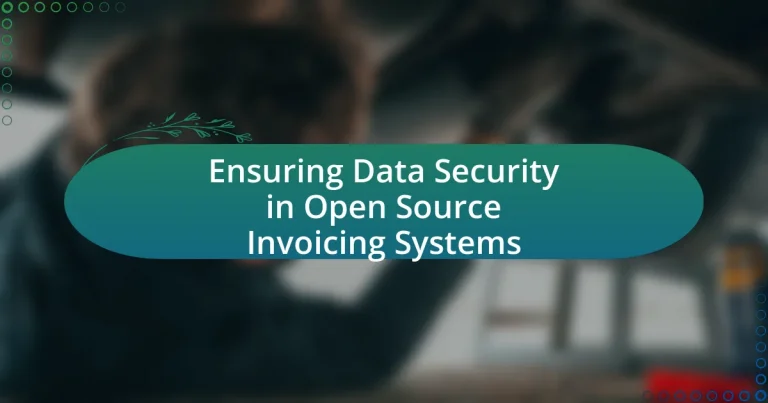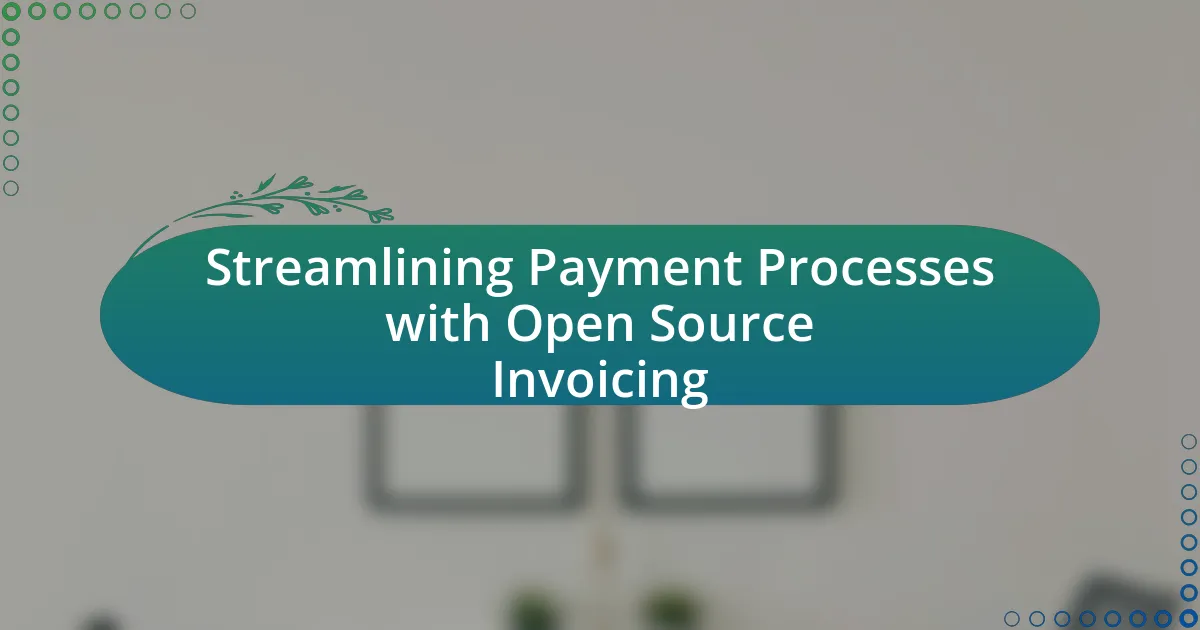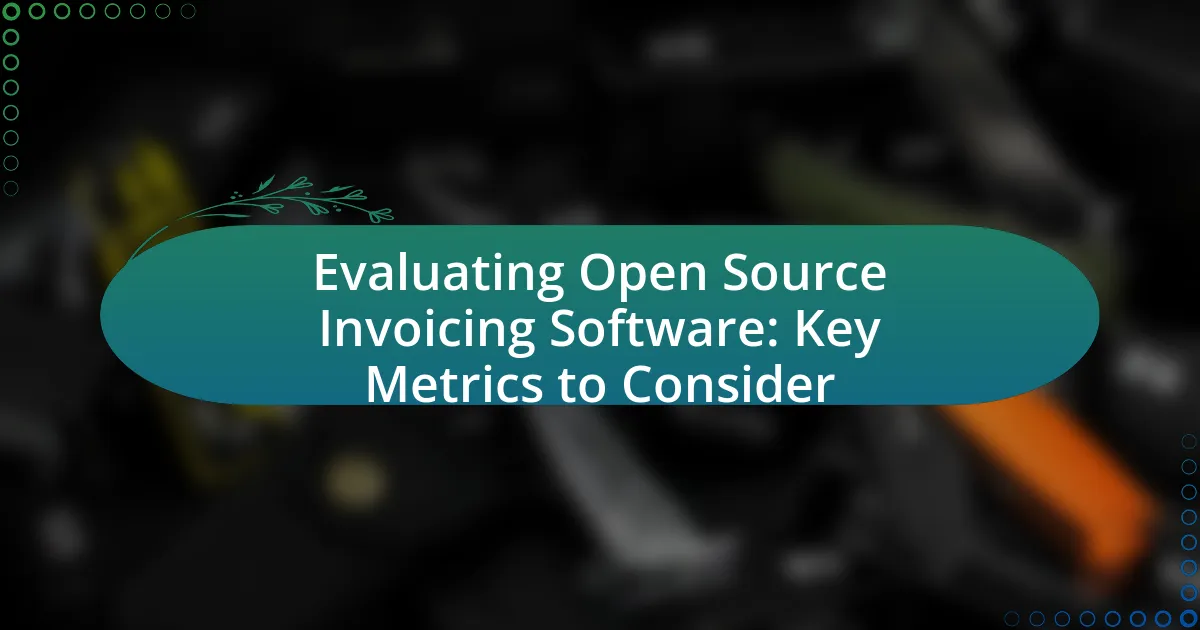Data security in open source invoicing systems encompasses the protocols and measures designed to protect sensitive financial information from unauthorized access and breaches. This article outlines the importance of data security, the types of sensitive data handled, and the potential impacts of data breaches on businesses. It also discusses common vulnerabilities, the role of coding practices and third-party integrations in security risks, and best practices for ensuring data protection. Additionally, the article highlights legal and compliance considerations, the significance of community support, and strategies for fostering a culture of security awareness within organizations.
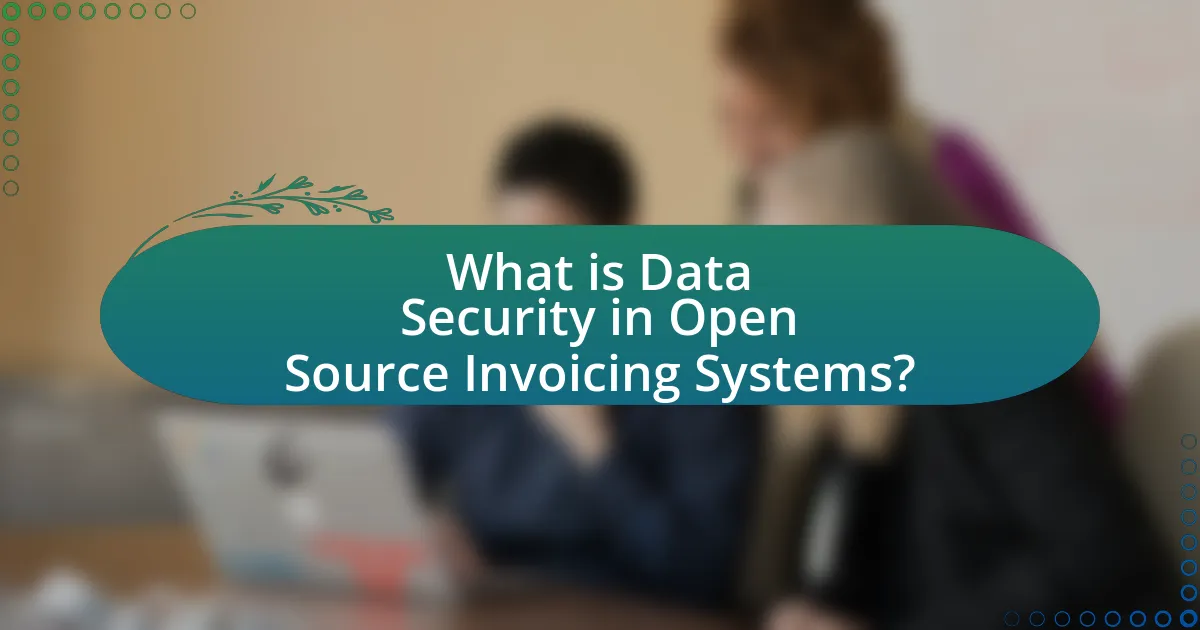
What is Data Security in Open Source Invoicing Systems?
Data security in open source invoicing systems refers to the measures and protocols implemented to protect sensitive financial information from unauthorized access, breaches, and data loss. These systems often utilize encryption, access controls, and regular security audits to safeguard user data. For instance, according to a 2021 report by the Open Web Application Security Project (OWASP), implementing strong authentication mechanisms and data encryption can significantly reduce the risk of data breaches in open source applications.
Why is data security crucial for open source invoicing systems?
Data security is crucial for open source invoicing systems because these systems often handle sensitive financial information, including payment details and personal data. The exposure of such data can lead to financial fraud, identity theft, and loss of customer trust. According to a report by the Ponemon Institute, the average cost of a data breach in 2021 was $4.24 million, highlighting the financial implications of inadequate security measures. Furthermore, open source software can be more vulnerable to attacks if not properly maintained, as its code is publicly accessible, allowing malicious actors to exploit vulnerabilities. Therefore, implementing robust data security practices is essential to protect sensitive information and maintain the integrity of open source invoicing systems.
What types of sensitive data are handled in these systems?
Open source invoicing systems handle various types of sensitive data, including personal identification information, financial details, and transaction records. Personal identification information may consist of names, addresses, and contact numbers, which are essential for invoicing and customer management. Financial details include bank account numbers, credit card information, and payment histories, which are critical for processing transactions securely. Transaction records encompass details of purchases, invoices issued, and payment statuses, all of which require protection to prevent unauthorized access and fraud. These data types are governed by regulations such as GDPR and PCI DSS, which mandate strict security measures to safeguard sensitive information.
How can data breaches impact businesses using open source invoicing systems?
Data breaches can severely impact businesses using open source invoicing systems by exposing sensitive financial and customer information, leading to financial losses and reputational damage. When a data breach occurs, unauthorized individuals may access confidential data such as payment details, client information, and transaction histories, which can result in fraud and identity theft. According to a 2020 report by IBM, the average cost of a data breach is $3.86 million, highlighting the financial repercussions for affected businesses. Additionally, businesses may face legal liabilities and regulatory fines if they fail to protect customer data, as mandated by laws such as the General Data Protection Regulation (GDPR). The loss of customer trust following a breach can also lead to decreased sales and long-term damage to brand reputation.
What are the common vulnerabilities in open source invoicing systems?
Common vulnerabilities in open source invoicing systems include SQL injection, cross-site scripting (XSS), and inadequate authentication mechanisms. SQL injection occurs when attackers manipulate input fields to execute arbitrary SQL queries, potentially compromising the database. Cross-site scripting allows attackers to inject malicious scripts into web pages viewed by other users, leading to data theft or session hijacking. Inadequate authentication mechanisms can result in unauthorized access, as weak password policies or lack of two-factor authentication leave systems exposed. According to the OWASP Top Ten, these vulnerabilities are prevalent in many web applications, including invoicing systems, highlighting the need for robust security measures.
How do coding practices affect the security of these systems?
Coding practices significantly affect the security of open source invoicing systems by determining how vulnerabilities are introduced and mitigated during development. Secure coding practices, such as input validation, proper error handling, and adherence to security frameworks, reduce the risk of common vulnerabilities like SQL injection and cross-site scripting. For instance, a study by the Open Web Application Security Project (OWASP) highlights that 75% of web applications are vulnerable to such attacks due to poor coding practices. Therefore, implementing robust coding standards and regular code reviews can enhance the overall security posture of these systems, making them less susceptible to exploitation.
What role do third-party integrations play in security risks?
Third-party integrations significantly increase security risks by introducing vulnerabilities that can be exploited by malicious actors. These integrations often require access to sensitive data and system functionalities, which can lead to data breaches if the third-party service is compromised. For instance, a study by the Ponemon Institute found that 59% of organizations experienced a data breach due to a third-party vendor, highlighting the critical nature of these risks. Additionally, third-party services may not adhere to the same security standards as the primary system, further exacerbating the potential for exploitation.
What best practices can be implemented to ensure data security?
To ensure data security, organizations should implement encryption, access controls, regular updates, and employee training. Encryption protects sensitive data by converting it into a secure format, making it unreadable without the appropriate decryption key. Access controls limit data access to authorized personnel only, reducing the risk of unauthorized exposure. Regular updates to software and systems patch vulnerabilities, as evidenced by the fact that 60% of breaches occur due to unpatched software. Employee training enhances awareness of security protocols and phishing threats, which is crucial since human error accounts for 95% of cybersecurity incidents.
How can encryption be utilized to protect sensitive data?
Encryption can be utilized to protect sensitive data by converting it into a format that is unreadable without a decryption key. This process ensures that even if unauthorized individuals access the data, they cannot interpret it without the necessary credentials. For instance, the Advanced Encryption Standard (AES) is widely used to secure sensitive information, as it provides strong encryption through a symmetric key algorithm, making it difficult for attackers to decrypt the data without the key. According to a report by the National Institute of Standards and Technology (NIST), encryption is a critical component of data protection strategies, as it significantly reduces the risk of data breaches and unauthorized access.
What are the benefits of regular security audits and updates?
Regular security audits and updates enhance the overall security posture of open source invoicing systems by identifying vulnerabilities and ensuring compliance with security standards. These audits systematically evaluate the system for weaknesses, allowing organizations to address potential threats before they can be exploited. Furthermore, updates often include patches for known vulnerabilities, reducing the risk of data breaches. According to a study by the Ponemon Institute, organizations that conduct regular security audits can reduce the average cost of a data breach by up to 30%. This demonstrates that proactive security measures not only protect sensitive information but also lead to significant cost savings in the event of a security incident.
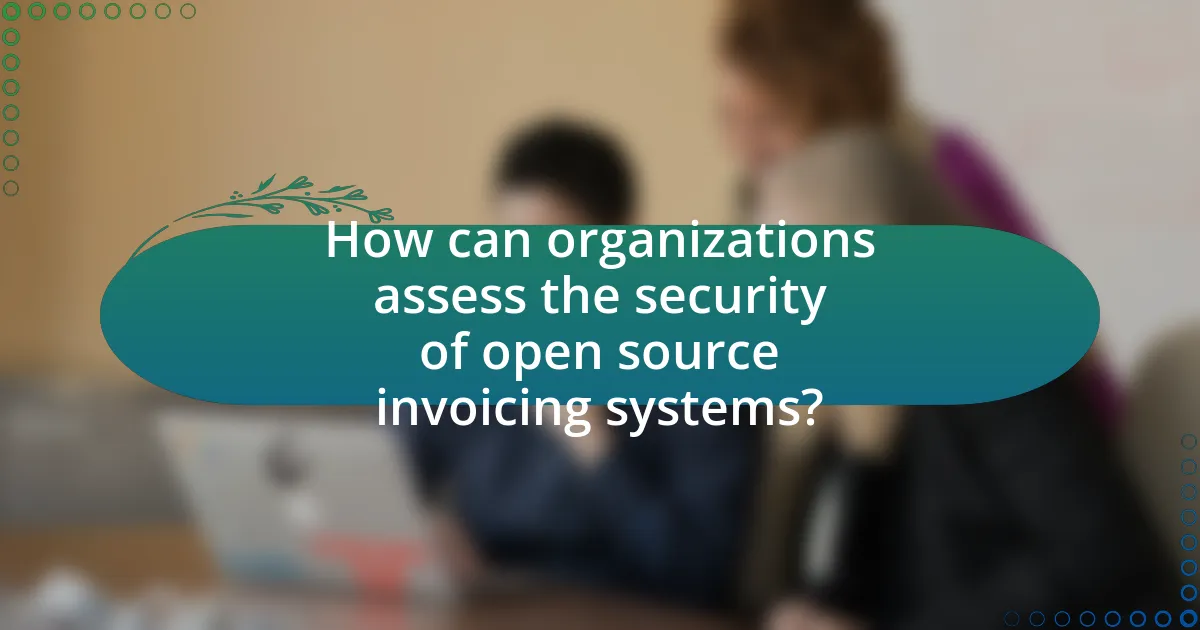
How can organizations assess the security of open source invoicing systems?
Organizations can assess the security of open source invoicing systems by conducting thorough code reviews, vulnerability assessments, and utilizing security auditing tools. Code reviews allow organizations to identify potential security flaws in the software’s source code, while vulnerability assessments help in detecting known security issues through automated scanning tools. Additionally, organizations should evaluate the community support and update frequency of the open source project, as active communities often address security vulnerabilities more promptly. According to a 2020 study by the Open Source Security Foundation, 70% of vulnerabilities in open source software can be mitigated through regular updates and community engagement, highlighting the importance of these assessment methods.
What tools are available for evaluating security in these systems?
Tools available for evaluating security in open source invoicing systems include static analysis tools, dynamic analysis tools, and vulnerability scanners. Static analysis tools, such as SonarQube, analyze source code for potential security vulnerabilities without executing the program, allowing developers to identify issues early in the development process. Dynamic analysis tools, like OWASP ZAP, test running applications for security flaws by simulating attacks, providing insights into how the system behaves under threat. Vulnerability scanners, such as Nessus, automate the detection of known vulnerabilities in software and configurations, helping organizations maintain secure environments. These tools are essential for ensuring the integrity and security of open source invoicing systems by identifying and mitigating risks effectively.
How do penetration testing and vulnerability scanning work?
Penetration testing and vulnerability scanning are two distinct but complementary security assessment methods used to identify and address security weaknesses in systems. Penetration testing simulates real-world attacks to exploit vulnerabilities, providing insights into how an attacker could gain unauthorized access or cause damage. This method involves planning, reconnaissance, exploitation, and reporting, often conducted by skilled ethical hackers who use various tools and techniques to mimic potential threats.
In contrast, vulnerability scanning is an automated process that identifies known vulnerabilities in systems, applications, and networks by comparing them against a database of vulnerabilities. This scanning process typically involves using specialized software to detect weaknesses without exploiting them, allowing organizations to prioritize and remediate issues based on severity.
Both methods are essential for ensuring data security in open source invoicing systems, as they help organizations proactively identify and mitigate risks, thereby protecting sensitive financial information from potential breaches.
What metrics should organizations track to measure security effectiveness?
Organizations should track metrics such as the number of detected security incidents, the time to detect and respond to incidents, and the percentage of systems compliant with security policies to measure security effectiveness. These metrics provide insights into the organization’s ability to identify and mitigate threats, as well as adherence to established security protocols. For instance, a study by the Ponemon Institute found that organizations with a robust incident response plan can reduce the average time to identify a breach by 27%, highlighting the importance of timely detection and response in enhancing security effectiveness.
What role does community support play in maintaining security?
Community support plays a crucial role in maintaining security by fostering collaboration and vigilance among users and developers. This collective effort enhances the identification and resolution of vulnerabilities, as community members share insights, report issues, and contribute to code reviews. For instance, open-source projects often benefit from a diverse group of contributors who can spot security flaws that a single entity might overlook, leading to more robust security measures. Additionally, community-driven initiatives, such as bug bounty programs, incentivize individuals to discover and report security weaknesses, further strengthening the overall security posture of open-source invoicing systems.
How can organizations contribute to the security of open source projects?
Organizations can contribute to the security of open source projects by providing funding, resources, and expertise to enhance the development and maintenance of these projects. For instance, financial support can enable the hiring of security experts who can conduct audits and vulnerability assessments, thereby identifying and mitigating risks. Additionally, organizations can contribute by actively participating in the community, reporting vulnerabilities, and contributing code improvements that enhance security features. A study by the Linux Foundation in 2021 highlighted that organizations investing in open source security initiatives saw a 50% reduction in vulnerabilities over a two-year period, demonstrating the effectiveness of such contributions.
What are the advantages of using well-maintained open source invoicing systems?
Well-maintained open source invoicing systems offer several advantages, including cost-effectiveness, flexibility, and enhanced security. These systems are typically free to use, which significantly reduces financial barriers for businesses. Additionally, their open-source nature allows for customization to meet specific business needs, enabling users to modify the software as required.
Moreover, well-maintained open source invoicing systems benefit from community-driven development, which often leads to quicker identification and resolution of security vulnerabilities. For instance, a study by the Open Source Security Foundation found that open source projects with active communities tend to have fewer security flaws due to continuous peer review and collaboration. This collaborative approach enhances the overall security posture of the invoicing system, making it a reliable choice for businesses concerned about data security.
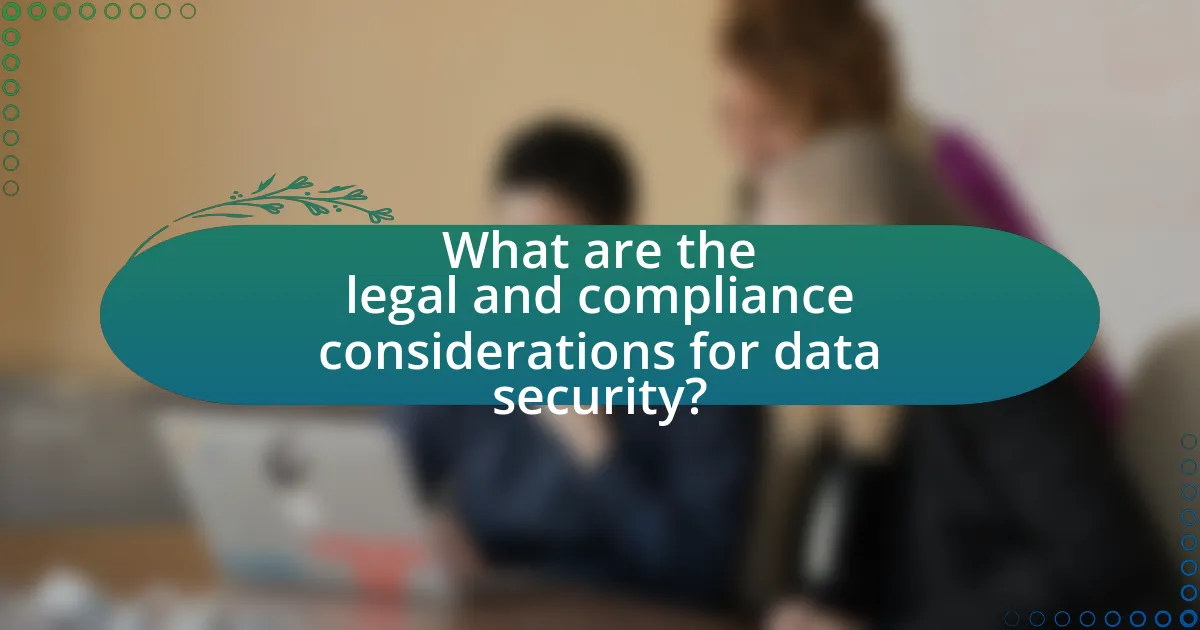
What are the legal and compliance considerations for data security?
Legal and compliance considerations for data security include adherence to regulations such as the General Data Protection Regulation (GDPR) and the Health Insurance Portability and Accountability Act (HIPAA). Organizations must ensure that they implement appropriate technical and organizational measures to protect personal data, conduct regular risk assessments, and maintain documentation of data processing activities. Non-compliance can result in significant fines; for instance, GDPR violations can lead to penalties of up to 4% of annual global turnover or €20 million, whichever is higher. Additionally, organizations must ensure that third-party vendors comply with relevant data protection laws to mitigate risks associated with data breaches.
What regulations must organizations comply with when using open source invoicing systems?
Organizations using open source invoicing systems must comply with regulations such as the General Data Protection Regulation (GDPR) in the European Union, the Health Insurance Portability and Accountability Act (HIPAA) in the United States for healthcare data, and the Payment Card Industry Data Security Standard (PCI DSS) for handling credit card information. Compliance with GDPR mandates that organizations protect personal data and privacy of EU citizens, while HIPAA requires safeguarding sensitive patient information. PCI DSS outlines security measures for organizations that process credit card transactions, ensuring data protection during financial transactions. These regulations are critical for maintaining data security and protecting user information in open source invoicing systems.
How do GDPR and other data protection laws affect these systems?
GDPR and other data protection laws impose strict requirements on open source invoicing systems regarding the handling of personal data. These regulations mandate that organizations must obtain explicit consent from individuals before collecting or processing their personal information, ensuring transparency about data usage. For instance, GDPR requires data controllers to implement appropriate technical and organizational measures to protect personal data, which directly influences the design and functionality of invoicing systems. Non-compliance can result in significant fines, as seen in 2021 when the French data protection authority fined a company €50 million for failing to comply with GDPR. Thus, adherence to these laws is crucial for the legal operation of open source invoicing systems.
What are the implications of non-compliance for businesses?
Non-compliance for businesses can lead to significant legal and financial repercussions. Businesses that fail to adhere to regulations, such as data protection laws, may face hefty fines; for instance, the General Data Protection Regulation (GDPR) can impose fines up to 4% of annual global turnover or €20 million, whichever is greater. Additionally, non-compliance can result in reputational damage, loss of customer trust, and potential lawsuits, which can further strain financial resources and operational capabilities. These implications underscore the critical importance of compliance in maintaining business integrity and sustainability.
How can organizations create a culture of security awareness?
Organizations can create a culture of security awareness by implementing comprehensive training programs that educate employees about security risks and best practices. Regular training sessions, combined with real-world scenarios and simulations, enhance understanding and retention of security protocols. According to a study by the Ponemon Institute, organizations that conduct regular security awareness training can reduce the likelihood of security breaches by up to 70%. Additionally, fostering open communication about security concerns and encouraging employees to report suspicious activities further strengthens this culture. By integrating security awareness into the organizational values and daily operations, companies can effectively promote a proactive approach to data security.
What training programs can be implemented for employees?
Training programs that can be implemented for employees include cybersecurity awareness training, data protection training, and secure coding practices. Cybersecurity awareness training educates employees on recognizing phishing attempts and understanding the importance of strong passwords, which is crucial for protecting sensitive data in open source invoicing systems. Data protection training focuses on compliance with regulations such as GDPR and HIPAA, ensuring employees understand their responsibilities in handling personal and financial information. Secure coding practices training equips developers with the knowledge to write code that minimizes vulnerabilities, thereby enhancing the overall security of the invoicing system. These programs are essential for fostering a culture of security and ensuring that employees are well-prepared to protect data effectively.
How can organizations encourage best security practices among users?
Organizations can encourage best security practices among users by implementing comprehensive training programs that focus on cybersecurity awareness. These programs should educate users about potential threats, such as phishing attacks and malware, and provide practical guidance on how to recognize and respond to these threats. Research indicates that organizations with regular security training see a 70% reduction in security incidents, highlighting the effectiveness of such initiatives. Additionally, organizations can establish clear security policies and procedures, promote a culture of accountability, and utilize tools like multi-factor authentication to enhance security measures.
What are the common troubleshooting steps for data security issues?
Common troubleshooting steps for data security issues include identifying the source of the breach, assessing the extent of the damage, and implementing immediate containment measures. First, organizations should conduct a thorough investigation to determine how the security issue occurred, which may involve reviewing logs and access controls. Next, they should evaluate the impact on data integrity and confidentiality, ensuring that sensitive information has not been compromised. Following this, it is crucial to isolate affected systems to prevent further unauthorized access. Finally, organizations should apply necessary patches, update security protocols, and educate staff on best practices to prevent future incidents. These steps are essential for maintaining data security and protecting sensitive information in open source invoicing systems.
